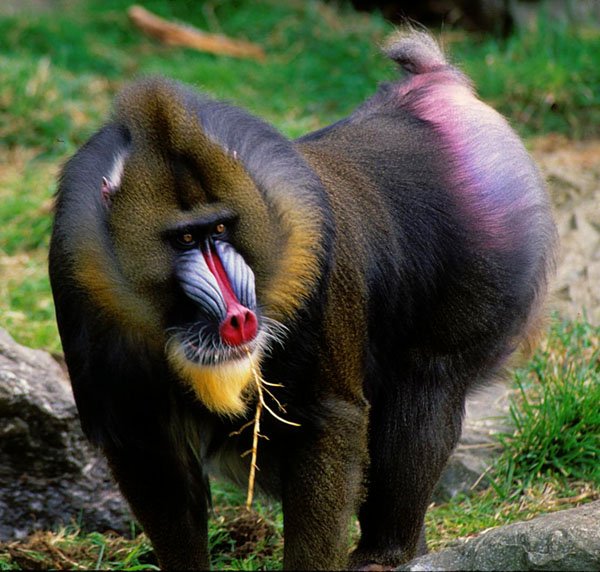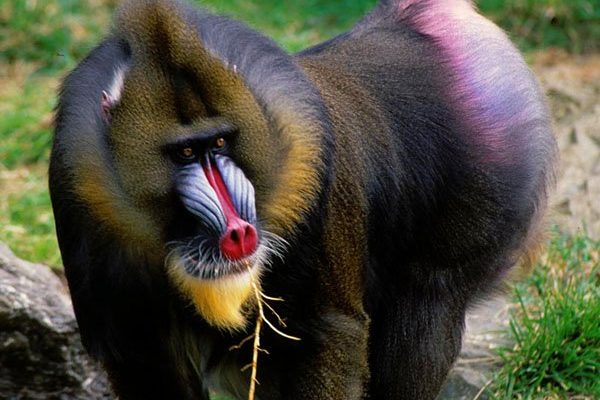
Let’s dive into this rich evolutionary tale. It’s like exploring a family tree, but instead of names, we’ll uncover species and habitats. From their roots in Africa to their current status, the mandrills show us how nature’s creativity works. So, pour yourself a cup of coffee, and let’s get started!
What Are Mandrills?
Mandrills, or *Mandrillus sphinx*, are often hailed as the largest of the monkeys, and they’re a unique species within the Old World monkeys’ family, which also includes baboons and macaques. They’re native to the tropical rainforests of Central Africa, specifically in countries like Gabon, Cameroon, and the Republic of Congo. What sets mandrills apart isn’t just their size; it’s their striking coloration. Males, in particular, flaunt colorful faces and rumps that can make a rainbow jealous.
You might wonder, why such bright colors? Well, in the animal kingdom, colors often serve purposes—like attracting mates or displaying health. For mandrills, males use their vivid features to signal dominance and fitness to potential partners. It’s like a peacock’s feathers, but with more muscle. Their social structure revolves around these flashy displays, which play a significant role in their survival.
The Origins of Mandrills
To understand where mandrills come from, we need to rewind the clock to about 30 million years ago. This period, known as the Miocene, was a golden age for primates. During this time, various primate species began diversifying, separating into different families and genera. The mandrill’s ancestors branched off from other primates around 12 million years ago, specifically from the group that would evolve into baboons and macaques.
Here’s the thing: the split didn’t happen overnight. Over millions of years, these ancestors adapted to suit their environments. As climate and landscapes changed, so did the mandrill’s characteristics. They developed traits that helped them thrive in their humid, forested homes—like strong limbs for climbing and an impressive diet that includes fruits, seeds, and insects.
Physical Adaptations
Mandrills are built for their particular lifestyle and habitat. Their powerful limbs allow them to navigate the treetops with ease. Think of them as the acrobats of the primate world, effortlessly swinging between branches. Their sharp, strong teeth help them munch on tough fruits and defend themselves against predators.
Additionally, their vibrant colors serve multiple functions. Males display their bright fur and facial features during social interactions, which can help establish their hierarchy within the troop. A dominant male often has the most striking colors and uses them to assert his status. Imagine a group of friends using their outfits to signal who’s in charge. In the mandrill troop, it’s all about those bold colors!
Social Structure and Behavior
Mandrills have a fascinating social structure that emphasizes cooperation and hierarchy. They typically live in groups called *hordes*, which can include up to several hundred individuals. In these groups, you’ll find a clear social order. Dominance is vital, often determined by size and color intensity, especially among males.
Speaking of behavior, mandrills display many interesting traits. For instance, they communicate through a mix of vocalizations, facial expressions, and body language. Whether it’s a grunt or a playful gesture, every interaction means something specific. This social complexity helps strengthen their bonds and organize their lives in the wild.
The Role of Habitat in Evolution
The habitat of mandrills—the tropical rainforests of Africa—has played a significant role in shaping their evolution. These forests provide plenty of food and cover, allowing them to thrive. However, as climates fluctuated and human activity increased, their habitats began to change.
Deforestation and habitat loss are major threats to mandrills today. With fewer trees to swing from and less food to eat, their survival is at risk. The evolution of mandrills isn’t just a tale from the past; it’s ongoing. Current changes in their environment could influence their future adaptations, much like how past environmental shifts shaped their ancestors.
Conservation Efforts
Given the threats mandrills face, conservation efforts have become increasingly important. Many organizations work tirelessly to protect their habitats and monitor their populations. Preserving the tropical rainforests is crucial, not just for mandrills but for countless species that share their home.
Additionally, education plays a vital role in conservation. By raising awareness about the significance of mandrills and the ecosystems they inhabit, we can inspire more people to care about their future. It’s like that saying—if we take care of the planet, the planet will take care of us. Protecting mandrills helps maintain biodiversity and the health of our environment.
The Future of Mandrills
So, what does the future hold for mandrills? Their evolutionary journey is far from over. As they adapt to changing environments, we can only hope for positive outcomes. With proper conservation efforts and habitat protection, there’s a chance for these vibrant primates to thrive for generations to come.
In the grand tapestry of life, mandrills remind us of the beauty of evolution and the importance of environmental stewardship. Their story intertwines with our responsibility to protect the natural world. You might be wondering if we can make a difference—and the answer is yes. Supporting conservation initiatives or simply educating ourselves and others can help ensure that these extraordinary creatures continue to exist.
In closing, the evolutionary history of mandrills is a captivating narrative that showcases resilience and adaptability. Their journey teaches us valuable lessons about nature and our role in preserving it. So the next time you see a mandrill, whether in a documentary or a zoo, remember the incredible journey they’ve taken—and let’s all do our part to protect their future.

